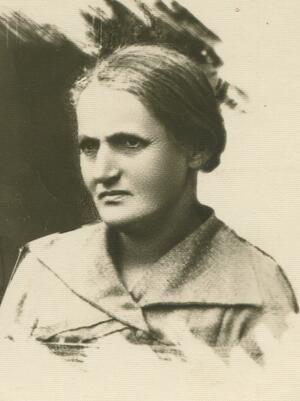Feiga's Choice: Tracing One Family's History of Resilience from South Africa to Ukraine
Tess Peacock comes from a long line of strong Jewish women. As a South African human rights attorney, she believes passionately in equality and dignity for all. It’s a value she learned from her mother, Judy Favish—a former anti-apartheid activist now on staff at the University of Cape Town where she works to ensure equal access to education for all. Judy’s mother was a pioneering doctor working in the townships. Her father Mannie was an attorney known for his integrity, compassion, and pursuit of fairness. But it was his mother—Feiga Shamis—to whom Judy and Tess feel they owe their strength, resilience, and commitment to human rights.
Feiga Shamis was no one of consequence really. But this seemingly ordinary woman survived the seemingly unsurvivable and wrote about it, opening a rare window into a tragic and forgotten piece of Jewish history.
Feiga was a mother of 12 through an arranged but seemingly happy marriage. Her quiet life in the Russian Pale of Settlement, where the Imperial Government restricted Jews to live, ended abruptly after the outbreak of WWI. Fearful Yiddish-speaking Jews would become spies for the Germans, the Russian government expelled the Jews from the Pale. Feiga and her family spent the next six years as refugees. With her husband often ill, Feiga hustled—buying and selling old clothes, making and selling vodka—whatever she needed to do to survive.
The Russian Revolution brought chaos and violence. After decades of state-sponsored anti-Semitism, increasingly desperate and militarized groups took out their anger and frustration on the Jews. These pogroms were unlike anything the Jews had seen before. Earlier waves had focused on looting and destruction with body counts totaling several thousand. The pogroms of 1917-1921 were far worse, with a body count of as many as 250,000. Feiga and her family were caught smack in the middle. “We overheard them saying they should kill all the Jewish children so the Jews would die out,” Feiga wrote in her memoir.
The pogroms hit steadily, some lasting more than a week. Feiga’s 16-year-old son was killed, and her husband died from typhoid. Exhausted, she plotted her escape. With the older children married off or sent to the U.S., she fled to Warsaw with the four youngest.
Then, Feiga made the fateful decision put her children in an orphanage—a common practice at the time. “I thought the children would be safer in the orphanage,” Feiga wrote, “so I took them there.”
By 1921, word of the violence and the growing orphan problem in Eastern Europe—at least 300,000 Jewish orphans alone—had spread around the world. Isaac Ochberg, a Jewish South African philanthropist, mounted an effort to rescue 200 Jewish orphans from his former homeland. At great risk to his own safety, he traveled around Eastern Europe collecting children from various orphanages and warehousing them at an orphanage in Warsaw—the very same orphanage where Feiga had put her children. There, the children told stories about wild animals roaming the streets of South Africa. At least a dozen children ran away, fearful of being taken to this dangerous new land. Ochberg, looking to fill his quota, turned to children already at the orphanage, choosing 8-year-old Mannie and 10-year-old Rose. Only later did he learn the children’s mother—Feiga—was alive.
When Feiga learned what had happened, she faced a heartbreaking decision—keep the children with her, or let them go a continent away where she would likely never see them again, but where she was assured they faced a better future. She chose to let them go.
For the rest of his life, Mannie would wonder what he had done to be sent away, and neither he nor his sister Rose would talk about their past. Years later, after a family outing to see the film Sophie’s Choice, Mannie broke down in tears, and Judy realized that something terrible had happened to her father as a child. Later, she learned Feiga had given him a long letter, handwritten in Yiddish in a composition notebook. It was Feiga’s attempt to explain her choice. But Mannie never read it. Only after Mannie’s death did his wife Nora get a good translation and distribute it to the family.
This little book, entitled Shalom Shalom, is a precious document. First-hand accounts of the Civil War pogroms are relatively rare, and an account by a woman even more so.
Two years ago, the book launched a quest. With Shalom, Shalom as their guide, Judy and Tess set out on a trip to Poland and what is now Ukraine, hoping to understand why Mannie would never talk about his past and what drove Feiga to the choice she made. They found a landscape virtually erased of its Jewish past—a fact that angered Tess and drove Judy to search for further clues.
Only this past summer, with help from Brandeis scholar Irina Astashkevich, did Judy find some answers. Astashkevich has spent more than a decade studying the Civil War pogroms in the YIVO archives in New York City. There she has learned the targets of these pogroms were often women and children. Women were subjected to mass, public rape, and children were often mutilated. Astashkevich believes Feiga and her daughters were at best witnesses, and at worst, victims themselves. This family trauma has trickled down to create multiple generations of strong Jewish women seeking justice, equality, and an end to persecution.
“I think we should all care about persecution everywhere,” says Tess. “The more we know about pain and suffering across racial lines, across cultural lines, the more we understand each other. In South Africa, the fact that I come from a Jewish background often helps me to connect with black South Africans because of the persecution that is somewhat shared. Obviously, the more that people learn from the past, the more we understand it and hope that these things are not repeated. That’s why history is so important.”
Tess Peacock is currently in the U.S. pursuing a master’s in socio-economic rights at Harvard. Judy’s quest, and the history behind it, are the subject of an upcoming documentary currently entitled Feiga’s Choice. To learn more about the film, visit the website at feigaschoice.com.








